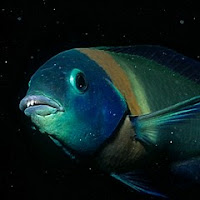
One thing that happens when you begin to take photos is that you start to pay attention to details you might not have noticed otherwise. For me, this noticing of details about my underwater photo subjects progressed in a systematic way.
When I first began to dive, I just saw "fish" and "crabs" and "starfish," but couldn't distinguish among the species of each. Over time I learned to recognize features common to different families of creatures. I could distinguish the butterflyfish from the angelfish, for example.
Next I learned to identify distinct species within families and, in some cases, whether individuals were male or female. My photos began to reflect that knowledge: I began to 'collect' species -- trying everywhere we went to photograph examples of as many different species as I could find.
Eventually I focused on details that reflected the creatures' individuality. In particular, I began to pay close attention to their faces or -- for creatures that didn't have faces in the usual sense -- their eyes. (This photo of a conch shell's eyes, and this one of a cross-eyed cone shell, are examples.)
Faces, more than any other visible feature, are emblematic of individuality. Our own faces are what instantly set us apart from one another visually. Sometimes we humans tend to overlook the fact that creatures in the wild also have faces -- and individuality.
We have accumulated a collection of photos that we call Faces on the Reef. We think that they illustrate the point that marine creatures, too, have individuality.
The little guy in the photo on this page is a Saddle Wrasse (Thalassoma duperrey). We just love the goofy look on his face, and those wonderful protruding front teeth. The one pictured here is a male, roughly 8 inches (21 cm) long. He was photographed at Honaunau Bay, Hawaii.
This species is very common on reefs in Hawaiian waters, and individuals can be quite friendly toward divers. They'll sometimes swim up and peer right into a diver's mask -- maybe they're looking at our eyes! -- and they'll often follow divers around the reef. If a diver should stop to turn over a rock to see what's under it, the Saddle Wrasse will be right there to look, too. If the wrasse sees something good to eat, he'll grab it and then move along to the next rock and wait, looking back at the diver as if to say, "Well come on, turn this one over next."
The Hawaiian name for the Saddle Wrasse is hinalea lauwili.

BNSullivan.jpg)
BNSullivan465x300.jpg)
BNSullivan.jpg)


BNSullivan.jpg)

That would be so amusing to have them with you so that you could provide the rock turning for them.
ReplyDeleteThese little fish are one of a number of species that are so attractive, and often seem to be so friendly, that we have to keep reminding ourselves that they are wild animals, not pets. In any case, yes, we do enjoy their company when we dive.
ReplyDeleteBobbie